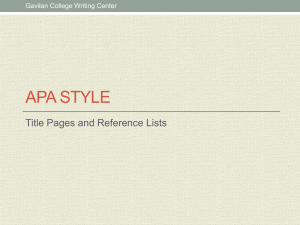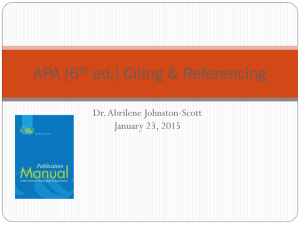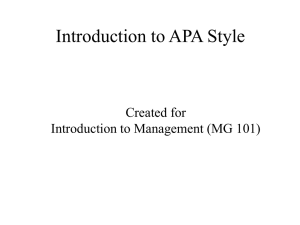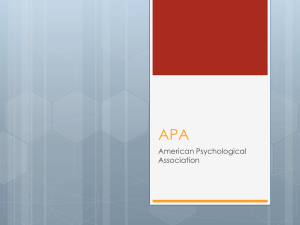Electronic Media and URLs
advertisement
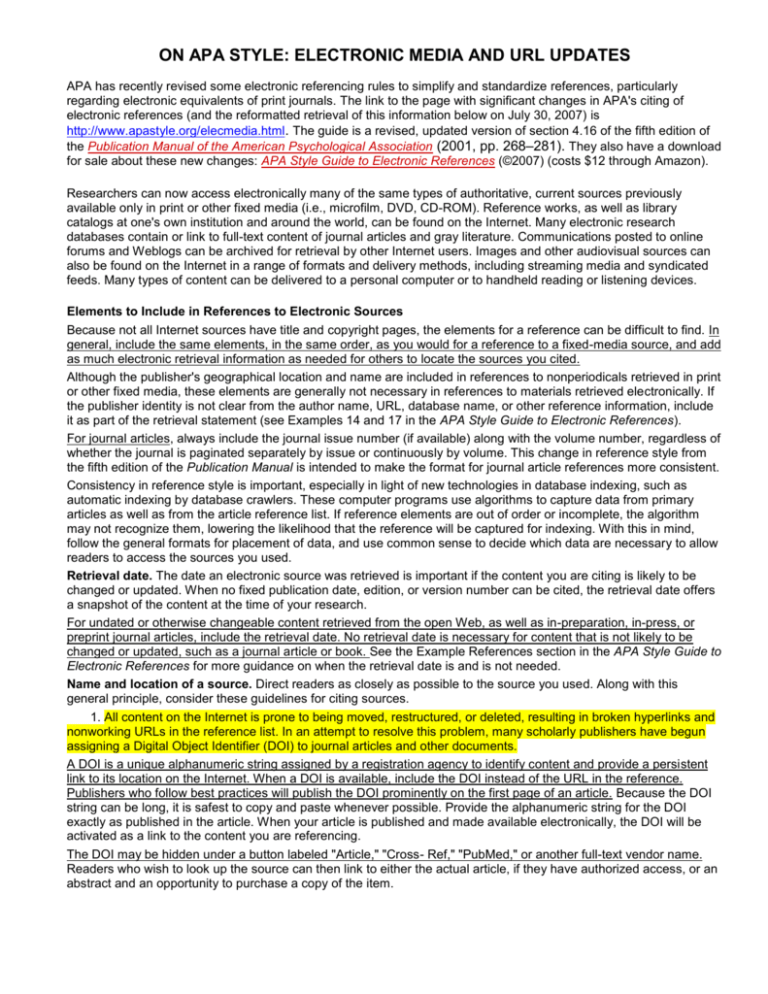
ON APA STYLE: ELECTRONIC MEDIA AND URL UPDATES APA has recently revised some electronic referencing rules to simplify and standardize references, particularly regarding electronic equivalents of print journals. The link to the page with significant changes in APA's citing of electronic references (and the reformatted retrieval of this information below on July 30, 2007) is http://www.apastyle.org/elecmedia.html. The guide is a revised, updated version of section 4.16 of the fifth edition of the Publication Manual of the American Psychological Association (2001, pp. 268–281). They also have a download for sale about these new changes: APA Style Guide to Electronic References (©2007) (costs $12 through Amazon). Researchers can now access electronically many of the same types of authoritative, current sources previously available only in print or other fixed media (i.e., microfilm, DVD, CD-ROM). Reference works, as well as library catalogs at one's own institution and around the world, can be found on the Internet. Many electronic research databases contain or link to full-text content of journal articles and gray literature. Communications posted to online forums and Weblogs can be archived for retrieval by other Internet users. Images and other audiovisual sources can also be found on the Internet in a range of formats and delivery methods, including streaming media and syndicated feeds. Many types of content can be delivered to a personal computer or to handheld reading or listening devices. Elements to Include in References to Electronic Sources Because not all Internet sources have title and copyright pages, the elements for a reference can be difficult to find. In general, include the same elements, in the same order, as you would for a reference to a fixed-media source, and add as much electronic retrieval information as needed for others to locate the sources you cited. Although the publisher's geographical location and name are included in references to nonperiodicals retrieved in print or other fixed media, these elements are generally not necessary in references to materials retrieved electronically. If the publisher identity is not clear from the author name, URL, database name, or other reference information, include it as part of the retrieval statement (see Examples 14 and 17 in the APA Style Guide to Electronic References). For journal articles, always include the journal issue number (if available) along with the volume number, regardless of whether the journal is paginated separately by issue or continuously by volume. This change in reference style from the fifth edition of the Publication Manual is intended to make the format for journal article references more consistent. Consistency in reference style is important, especially in light of new technologies in database indexing, such as automatic indexing by database crawlers. These computer programs use algorithms to capture data from primary articles as well as from the article reference list. If reference elements are out of order or incomplete, the algorithm may not recognize them, lowering the likelihood that the reference will be captured for indexing. With this in mind, follow the general formats for placement of data, and use common sense to decide which data are necessary to allow readers to access the sources you used. Retrieval date. The date an electronic source was retrieved is important if the content you are citing is likely to be changed or updated. When no fixed publication date, edition, or version number can be cited, the retrieval date offers a snapshot of the content at the time of your research. For undated or otherwise changeable content retrieved from the open Web, as well as in-preparation, in-press, or preprint journal articles, include the retrieval date. No retrieval date is necessary for content that is not likely to be changed or updated, such as a journal article or book. See the Example References section in the APA Style Guide to Electronic References for more guidance on when the retrieval date is and is not needed. Name and location of a source. Direct readers as closely as possible to the source you used. Along with this general principle, consider these guidelines for citing sources. 1. All content on the Internet is prone to being moved, restructured, or deleted, resulting in broken hyperlinks and nonworking URLs in the reference list. In an attempt to resolve this problem, many scholarly publishers have begun assigning a Digital Object Identifier (DOI) to journal articles and other documents. A DOI is a unique alphanumeric string assigned by a registration agency to identify content and provide a persistent link to its location on the Internet. When a DOI is available, include the DOI instead of the URL in the reference. Publishers who follow best practices will publish the DOI prominently on the first page of an article. Because the DOI string can be long, it is safest to copy and paste whenever possible. Provide the alphanumeric string for the DOI exactly as published in the article. When your article is published and made available electronically, the DOI will be activated as a link to the content you are referencing. The DOI may be hidden under a button labeled "Article," "Cross- Ref," "PubMed," or another full-text vendor name. Readers who wish to look up the source can then link to either the actual article, if they have authorized access, or an abstract and an opportunity to purchase a copy of the item. Example of reference in electronic document with DOI hidden behind a button If the link is not live or if the DOI is referenced in a print publication, the reader can simply enter the DOI into the "DOI resolver" search field provided by the registration agency CrossRef.org and be directed to the article or link to purchase it (see Figure 1). Figure 1. Digital Object Identifier resolver provided by CrossRef.org, a registration agency for scholarly and professional publications. 2. With the exception of hard-to-find books and other documents of limited circulation delivered by electronic databases, the database name is no longer a necessary element of the reference. This change is made in the interest of simplifying reference format. If you do include the database name in a reference, do not include the database URL. 3. Test URLs in your reference list at each stage prior to the submission and/or publication of your work. If the document you are citing has moved, update the URL so that it points to the correct location. If the document is no longer available, you may want to substitute another source (e.g., if you originally cited a draft and a formally published version now exists) or drop it from the paper altogether. 4. Give the home or menu page URL for works whose full text is accessible by subscription only. 5. Give the home or menu page URL for reference works, such as online dictionaries or encyclopedias. 6. Give the home or menu page URL for online material presented in frames. Frames are used in programming code to allow a Web page to be divided into two or more independent parts, with the result that several disparate items may share the same URL. Test your URLs in a fresh browser session or tab to be sure they lead directly to the desired content. If they do not, reference the home or menu page instead. Understanding a URL Critical evaluation of sources from the Internet can be a challenge; there are fewer gatekeepers in electronic publishing than in print publishing, and author and copyright information can be absent or hard to locate. Understanding the components of a URL can be helpful in this evaluation process. The components of a URL are as follows: The protocol indicates what method a Web browser (or other type of Internet software) should use to exchange data with the file server on which the desired document resides. The protocols recognized by most browsers are hypertext transfer protocol (http), hypertext transfer protocol secure (https), and file transfer protocol (ftp). In a URL, protocol is followed by a colon and two forward slashes (e.g., http://). The domain name or host name identifies the server on which the files reside. On the Web, it is often the address for an organization's home page (e.g., http://www.apa.org is the address for the home page of the American Psychological Association [APA]). Although many domain names start with "www," not all do (e.g., http://journals.apa.org is the home page for APA's electronic journals, and http://members.apa.org is the entry page to the members-only portion of the APA site). The domain name is not case sensitive; for consistency and ease of reading, always type it in lowercase letters. The domain name extension (in the preceding example, ".org") can help you determine the appropriateness of the source for your purpose. Different extensions are used depending on what entity hosts the site. For example, the extensions ".edu" and ".org" are for educational institutions and nonprofit organizations; ".gov" and ".mil" are used for government and military sites, respectively; and ".com" and ".biz" are used for commercial sites. Domain name extensions may also include a country code (e.g., ".ca" for Canada or ".nz" for New Zealand). The rest of the address indicates the directory path leading to the desired document. This part of the URL is case sensitive; transcribe the URL correctly by copying it directly from the address window in your browser and pasting it into your working document (make sure the automatic hyphenation feature of your word processor is turned off). Do not insert a hyphen if you need to break a URL across lines; instead, break the URL before most punctuation (an exception would be http://). Do not add a period after the URL, to prevent the impression that the period is part of the URL. Using the Archival Copy or Version of Record As with references to material in print or other fixed media, it is preferable to cite the final version (i.e., archival copy or version of record). In-progress and final versions of the same work might coexist on the Internet, which can present challenges in determining which version is most current and most authoritative. Most journals now consider the paper version to be the archival copy; however, this is likely to change in the future. Some scholarly journals do not offer print; all their content is online. More and more publishers of print journals are adding value to their electronic content by publishing auxiliary electronic-only items such as peer commentary with author response, data analyses, and enhanced or extra graphics. For these items, the electronic version may be considered the version of record. CITATIONS IN TEXT OF ELECTRONIC MATERIAL The following is excerpted from the 5th edition of the Publication Manual (© 2001). Some elements of the fifth edition's style guidelines for electronic resources differ from previously published guidelines. To cite a specific part of a source, indicate the page, chapter, figure, table, or equation at the appropriate point in text. Always give page numbers for quotations (see section 3.34). Note that the words page and chapter are abbreviated in such text citations: (Cheek & Buss, 1981, p. 332) (Shimamura, 1989, chap. 3) For electronic sources that do not provide page numbers, use the paragraph number, if available, preceded by the paragraph symbol or the abbreviation para. If neither paragraph nor page numbers are visible, cite the heading and the number of the paragraph following it to direct the reader to the location of the material (see section 3.39). (Myers, 2000, ¶ 5) (Beutler, 2000, Conclusion section, para. 1) SPELLING IN THE ELECTRONIC WORLD As indicated in the 5th edition of the Publication Manual, dictionaries are not the best guide to spelling in the electronic world. This is an extremely fast moving environment and common usage develops quickly, leaving print resources easily bypassed. The APA Style site will attempt to be more responsive. Below is a list of common terms and their preferred spelling. database DOI e-journal e-mail FTP Internet LISTSERV* (tm) – the generic term is electronic mailing list online PDF SGML URL Web *LISTSERV is a trademarked, proprietary term; unless you know that is what is being used, you should use "electronic mailing list" rather than the, admittedly, more commonly used "list server."


